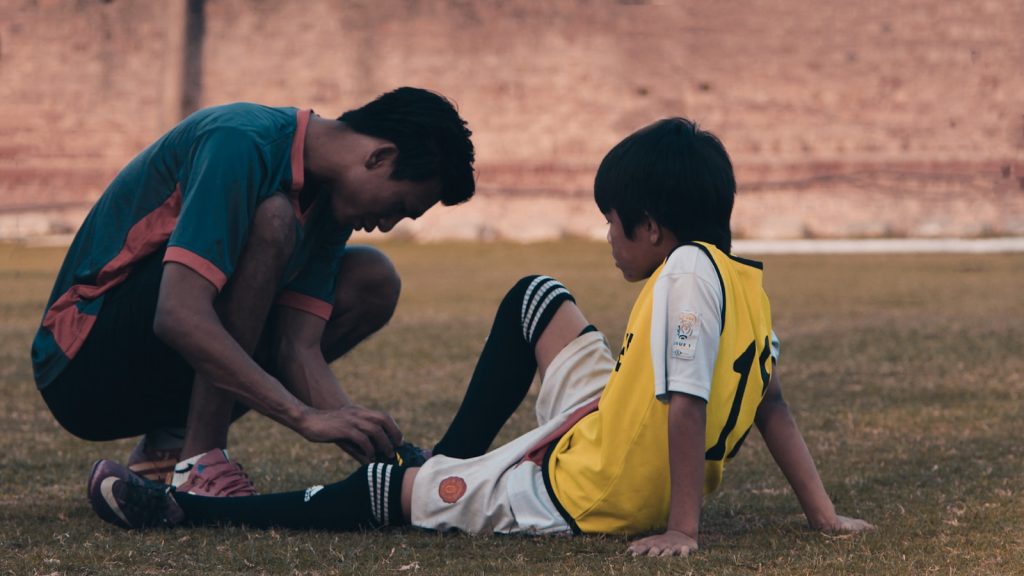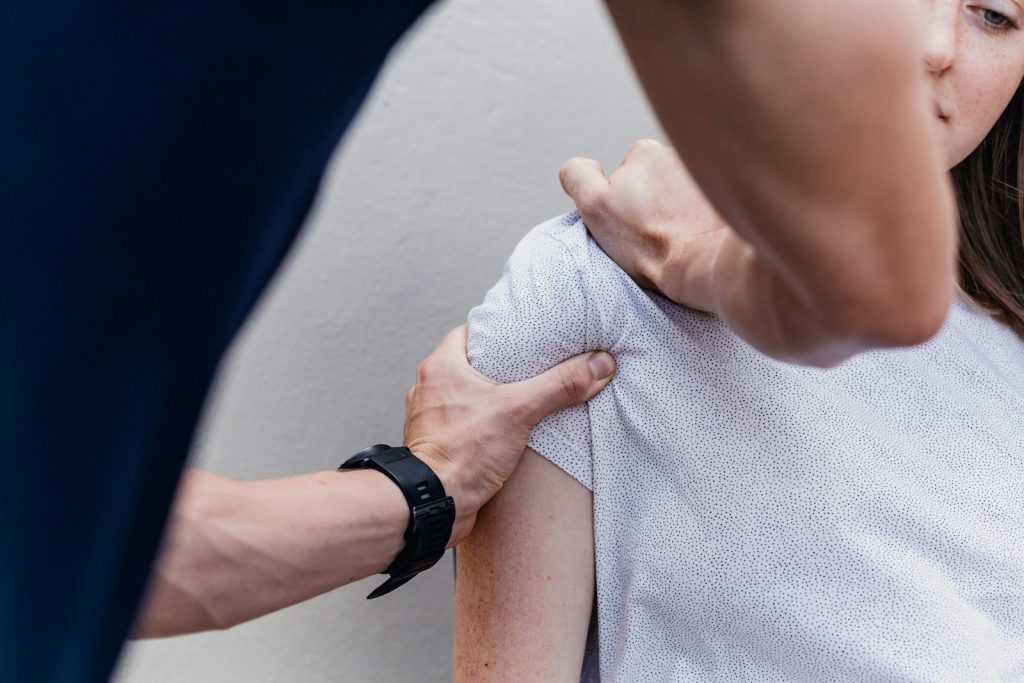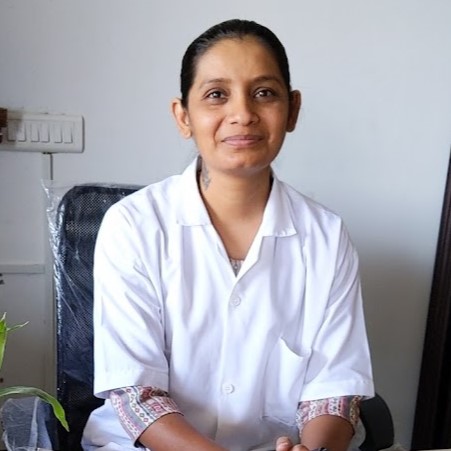As a seasoned physiotherapist at Dr. Unnati’s Physio Clinic in Ahmedabad, I often treat patients suffering from acute soft tissue injuries. One fundamental strategy we employ is the RICE method for injury, which stands for Rest, Ice, Compression, and Elevation. This method is crucial in the early management of injuries such as sprains, strains, and bruises. By effectively reducing inflammation, alleviating pain, and accelerating the recovery process, the RICE method sets a strong foundation for further rehabilitation as needed.
Table of Contents
Introduction to the RICE Method
Rest: This initial step is crucial as it involves ceasing any activity that might aggravate the injury. Allowing the affected area to rest minimizes further tissue damage and kick-starts the healing process.
Ice: Applying ice to the injured site significantly helps in reducing swelling and numbing the pain, making it a critical immediate response. It is recommended to apply ice wrapped in a cloth to avoid skin damage, for about 15-20 minutes every couple of hours during the initial 48 hours post-injury.
Compression: Utilizing an elastic bandage to wrap the injured area helps in minimizing swelling by preventing fluid build-up. Care should be taken to ensure the bandage is snug but not overly tight, which could impede blood flow and worsen the situation.
Elevation: Elevating the injured part above the heart level helps reduce swelling by facilitating fluid drainage away from the injury site. This can be easily achieved by using pillows to prop up the injured limb.
Implementing the RICE method swiftly after an injury can substantially mitigate the immediate symptoms and set the stage for effective recovery. This protocol is particularly beneficial as it is simple to administer and can be applied by anyone, anywhere, making it a first-line treatment in sports and at-home care settings.
By embracing these initial measures, patients can actively participate in their recovery process, ensuring a faster return to daily activities. As we move forward, understanding the nuances of each step and how they contribute to overall recovery is essential for anyone looking to manage injuries effectively.

When to Use the RICE Method for Injury
Identifying when to apply the RICE method is critical for its effectiveness in treating soft tissue injuries. This method is particularly beneficial in the initial phase of injury when quick action can prevent more severe complications such as excessive swelling and prolonged pain. The RICE method is most appropriate for injuries such as:
- Sprains: Ligament injuries caused by overstretching or tearing, commonly affecting ankles, wrists, and knees.
- Strains: Muscle or tendon injuries resulting from overuse or forceful movement, often occurring in the back, neck, and hamstring.
- Contusions (Bruises): Caused by direct blows or impact, leading to blood pooling under the skin and painful swelling.
Understanding Symptoms that Indicate the Need for RICE
The symptoms indicating the need for the RICE method include:
- Pain: Sudden and sharp discomfort that persists and worsens with movement or pressure.
- Swelling: Visible enlargement of the affected area, often accompanied by bruising or discolouration.
- Reduced Mobility: Difficulty moving the injured part normally due to stiffness or pain.
How the RICE Method Aids Recovery
Reducing Swelling: Swelling is a natural reaction of the body to injury, but excessive swelling can delay the healing process and increase discomfort. By compressing the area and elevating it, the RICE method helps limit the space available for swelling and facilitates fluid drainage.
Alleviating Pain: Cold therapy numbs the affected area, providing immediate pain relief. Compression also helps in reducing throbbing pain by stabilizing the injured tissues.
Preventing Additional Damage: Resting ensures that the injury is not aggravated further. Avoiding movement protects the area from additional stress and potential increases in injury severity.
Speeding Up the Healing Process: By efficiently managing the initial symptoms of an injury, the RICE method sets the stage for a good healing environment internally, thus speeding up the recovery process.
Knowing when and how to apply the RICE method effectively can empower individuals to take control of their injury management and ensure they are doing their best for their recovery right from the moment an injury occurs. As we further explore the nuances of pain management and recovery, understanding these foundational principles is essential for anyone involved in physical activities or prone to injuries.
The RICE method is a first-aid treatment and is generally recommended for minor injuries. For more severe injuries, it is crucial to seek professional medical advice to ensure appropriate care and avoid complications. Stay informed and proactive in managing injuries to maintain optimal health and wellness.
Limitations and Precautions of the RICE Method
While the RICE method is widely recommended for initial injury management, it’s crucial to recognize its limitations and necessary precautions to ensure it’s used safely and effectively.
Limitations of the RICE Method
- Not suitable for all injuries: RICE is generally effective for acute soft tissue injuries but may not be appropriate for fractures or injuries requiring immediate medical attention.
- Potential delay in professional care: Over-reliance on RICE could delay seeking professional medical evaluation, particularly if the injury is more severe than initially assessed.
- Limited long-term solution: While effective initially, RICE does not replace the need for a comprehensive rehabilitation program for complete recovery.
Precautions When Using the RICE Method
- Ice application: Ice should not be applied directly to the skin as it can cause frostbite or skin damage. Always use a barrier, like a cloth or towel, and limit each application to 20 minutes to avoid nerve damage.
- Compression: The wrap should be snug but not tight. Excessive compression can impede blood flow, worsening the injury. It’s important to check for signs of decreased circulation such as increased pain, tingling, or a cool feeling.
- Elevation: While elevation helps reduce swelling, it’s important to ensure that the limb or affected area is supported comfortably to avoid additional strain.
Understanding these precautions and limitations is essential to using the RICE method effectively. It ensures that while the immediate symptoms of an injury are managed, further harm is not caused inadvertently.
Incorporating RICE as part of a broader injury management strategy is crucial. After the initial 48 hours following an injury, other treatments such as gentle active movements and physical therapy may be necessary to aid recovery and prevent stiffness or long-term disability. Always consult with a healthcare professional or physiotherapist to tailor a safe and effective recovery plan based on the specifics of the injury.
Transition from RICE to Active Rehabilitation
After applying the RICE method during the initial stages of injury management, it’s important to know when and how to transition to more active rehabilitation techniques to ensure a full recovery. This phase is crucial as it helps restore strength, flexibility, and function to the affected area.
Signs That It’s Time to Move Beyond RICE
- Reduction in Swelling and Pain: Once the initial swelling and pain have decreased significantly, it may be time to start gentle movements to encourage more healing.
- Increased Mobility: As mobility starts to improve and maintaining positions becomes less painful, it’s an indicator that the body is ready for more active rehabilitation.
- Medical Clearance: Always consult with a healthcare professional to get clearance when transitioning to active rehabilitation, ensuring that the injury is adequately healed to withstand more activity.
Active Rehabilitation Techniques
- Gentle Active Movements: Begin with light, controlled movements within a pain-free range to encourage flexibility and blood flow. Activities like arm swings, light stretches, or walking can be gradually introduced based on the injury location.
- Strengthening Exercises: As the recovery progresses, specific exercises aimed at strengthening the muscles surrounding the injured area can be added. This helps support the joint and prevents future injuries.
- Physical Therapy: Working with a physiotherapist can provide tailored exercises and therapies suited to the specific needs and recovery stages of the injury. Physical therapy might include manual therapy, muscle strengthening, proprioception exercises, and more.
- Functional Training: This involves training the body to handle real-life movement patterns and activities, which helps in returning to daily activities or sports with confidence and reduced risk of re-injury.
Monitoring Progress
It’s vital to monitor progress and adjust the rehabilitation program as needed. Recovery varies by individual and the specific nature of the injury. Regular follow-ups with a physiotherapist ensure that the rehabilitation process promotes healing while avoiding setbacks.
Transitioning properly from RICE to active rehabilitation is key to a full and efficient recovery. It ensures that while the injury recovers from the acute phase with minimal adverse effects, it also regains full function through carefully guided exercises and therapies. This holistic approach to injury management not only addresses the immediate symptoms but also rehabilitates the injury for long-term health and mobility.
Role of Physiotherapy in Ongoing Injury Management

After the transition from initial rest and immobilization using the RICE method to more active rehabilitation, ongoing physiotherapy becomes crucial in managing and fully recovering from an injury. Physiotherapy plays a significant role in not only continuing the recovery process but also in preventing future injuries by strengthening and conditioning the body.
Comprehensive Physiotherapy Approaches
- Advanced Manual Therapies: These include techniques such as massage, mobilization, and manipulations that help improve tissue flexibility, reduce pain, and enhance joint function.
- Targeted Exercise Programs: Customized exercise regimens are designed to strengthen the injured area and surrounding muscles, improve endurance, and increase range of motion.
- Pain Management Techniques: Physiotherapy employs various methods such as ultrasound therapy, electrical stimulation (like TENS), and heat or cold therapy to manage and alleviate pain.
- Education on Body Mechanics: Physiotherapists educate patients on proper body mechanics and posture to prevent the recurrence of injuries. This includes training on how to lift objects properly, how to sit correctly at a desk, and other daily activities that can be adjusted to prevent strain.
Enhancing Recovery and Preventing Re-Injury
- Conditioning for Specific Activities: For athletes or individuals involved in specific sports or activities, physiotherapists tailor programs that not only aid in recovery but also prepare the body to safely return to these activities.
- Regular Monitoring and Adaptation: Treatment plans are regularly assessed and adapted based on the patient’s progress. This dynamic approach ensures that the rehabilitation process is effective and responds to the healing stages of the injury.
- Long-Term Health and Wellness Strategies: Beyond immediate recovery, physiotherapy focuses on long-term strategies to enhance overall health and prevent future injuries. This might include lifestyle modifications, regular fitness routines, and ongoing strength training.
Importance of a Holistic Approach
The comprehensive care provided by physiotherapy addresses not just the physical aspects of recovery but also the psychological impact of injuries. Managing pain, restoring confidence in physical abilities, and adapting lifestyle habits form an integral part of the holistic approach to physiotherapy.
Physiotherapy is essential in ensuring that once the acute phase of injury has been managed with methods like the RICE approach, the patient continues to recover fully and regain optimal functionality. Through a combination of advanced therapeutic techniques and personalized care plans, physiotherapy helps patients return to their daily activities, sports, and work safely and effectively. This ongoing management not only aids in recovery but also fortifies the body against potential future injuries, ensuring long-term health and mobility.
Preventive Measures and Injury Education
In the realm of physiotherapy, preventing future injuries is as crucial as treating existing ones. Effective injury prevention not only reduces the risk of future physical damage but also minimizes the potential psychological impact of recurring injuries. Here’s how physiotherapists at Dr. Unnati’s Physio Clinic incorporate preventive measures and injury education into their treatment plans:
Proactive Injury Prevention Strategies
- Routine Physical Assessments: Regular check-ups can help identify potential vulnerabilities before they turn into injuries. These assessments focus on evaluating posture, flexibility, strength, and the overall biomechanics of the body.
- Customized Exercise Programs: Depending on individual risk factors, tailored exercise programs are developed to strengthen weak areas, improve balance, and enhance flexibility, thereby reducing the likelihood of injuries.
- Ergonomic Advice: For patients whose lifestyle or job involves repetitive movements or prolonged periods of sitting, physiotherapists provide ergonomic advice. This might include recommendations on proper workplace setups, such as the correct height of chairs and desks, and the ideal positioning of computer screens.
Educating Patients for Long-Term Health
- Workshops and Seminars: Regular educational sessions are held to teach patients about the mechanics of their bodies, how injuries occur, and how they can be prevented through simple daily activities.
- Safe Practice Techniques: Patients are taught safe ways to engage in their favorite activities, whether it’s sports, gardening, or any other physical hobby. This education focuses on warming up properly, using the right equipment, and recognizing the signs of fatigue and stress.
- Lifestyle Adjustments: Guidance on lifestyle modifications such as dietary changes, stress management techniques, and the importance of adequate sleep, all of which play a significant role in preventing injuries and maintaining overall health.
Building a Culture of Awareness and Safety
Creating an environment where patients are aware of the importance of injury prevention is key. This involves encouraging a proactive approach to health, where regular exercise and correct posture are part of daily life, not just remedies for existing conditions.
Through these preventive measures and educational efforts, patients at Dr. Unnati’s Physio Clinic are equipped not only to recover from their current ailments but also to avoid future injuries and maintain a healthier, more active lifestyle. This holistic approach ensures that each patient achieves their personal health goals and sustains them over the long term, promoting a life free from the constraints of pain and injury.
Embracing a Holistic Approach to Physiotherapy
As we conclude this comprehensive exploration of physiotherapy from the initial RICE method to ongoing management and preventative strategies, it’s evident that embracing a holistic approach to physiotherapy is crucial. At Dr. Unnati’s Physio Clinic, our commitment extends beyond treating symptoms; we focus on enhancing overall health, preventing future injuries, and empowering our patients through education.
Integrated Care for Lasting Results
Physiotherapy is not merely about intervening after an injury has occurred. It encompasses a spectrum of care that includes preventive measures, treatment of acute and chronic conditions, and the promotion of healthier lifestyles. Our holistic approach ensures that each patient receives care tailored not only to their immediate needs but also to their long-term wellness goals.
The Power of Education and Prevention
We believe that an informed patient is an empowered patient. Through continuous education on body mechanics, safe exercise practices, and lifestyle choices, we equip our patients with the knowledge needed to take control of their health. This proactive approach significantly reduces the risk of injury and ensures that our patients can enjoy a high quality of life.
Commitment to Patient-Centered Care
At Dr. Unnati’s Physio Clinic, our highest priority is the well-being of our patients. We are committed to providing a supportive environment where patients feel valued and actively involved in their treatment plans. Our team of experts uses the latest research and techniques to ensure the best outcomes, fostering a positive, healing environment.
Looking Forward
The journey to optimal health is ongoing, and at Dr. Unnati’s Physio Clinic, we are your partners every step of the way. We encourage our patients to continue practicing the techniques they have learned, to engage regularly with our clinic, and to maintain an active lifestyle that supports their overall well-being.
In conclusion, whether you are recovering from an injury or seeking to prevent one, remember that your health is your most valuable asset. By incorporating a comprehensive physiotherapy approach, you are not only addressing current ailments but also investing in a healthier, more vibrant future. Thank you for trusting us with your care, and we look forward to supporting you in your journey to a healthier, more active life.

Dr Unnati Shah, BPT, MIAP, GSCPT, is a highly experienced physiotherapist with over 15 years of dedicated practice in the field. As the founder of Dr Unnati’s Physio Clinic in Gota, Ahmedabad, she specializes in treating a wide range of conditions, including sports injuries, orthopaedic issues, and chronic pain.